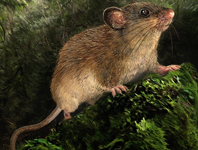Abstract
Kenya has a high diversity of agamid lizards and the arid northern frontier area has the highest species richness. Among the Kenyan agama species, Agama lionotus has the widest distribution, occurring from sea level to inland areas in both dry and moist savanna as well as desert areas. This species mostly prefers rocky areas, both in granitic/metamorphic and volcanic rocks, although it also makes use of tree crevices as well as man-made structures. Recently in Marsabit, northern Kenya, a small-sized agama species, distinct from A. lionotus, was collected within a rocky lava desert area. This new species is characterized by its small size (mean SVL ~83 mm) as compared to typical A. lionotus (mean SVL ~120 mm). Past studies have shown the value of adult male throat coloration for the identification of species within the A. lionotus complex. Herein we also highlight female dorsal color pattern, which is a key character for distinguishing the new species from others in the group, including the similar A. hulbertorum. As in A. lionotus, displaying adult males have an orange to yellow head, a vertebral stripe, a bluish body coloration and an annulated white/blue tail. But the most diagnostic character is the coloration of females and non-displaying males, which exhibit a series of regular pairs of dark spots along the vertebrae as far posterior as the tail base. In addition, females have a pair of elongated orange or yellow marks on the shoulders and another on the dorsolateral margins of the abdomen. This study shows that more cryptic species in the Agama lionotus complex may still await discovery. The new species was found inhabiting dark desert lava rocks but should additionally be present in suitably similar sites in the northern frontier area. This underscores the need to re-examine populations of Agama lionotus from different microhabitats in this country.
References
Böhme, W., Wagner, P., Malonza, P., Lötters, S. & Köhler, J. (2005) A new species of the Agama agama group (Squamata: Agamidae) from Western Kenya, East Africa, with comments on Agama lionotus Boulenger, 1896. Russian Journal of Herpetology, 12 (2), 83–90.
Boulenger, G.A. (1885) Description d’une espèce nouvelle d’agame. Annali del Museo Civico di Storia Naturale di Genova, Serie 2a, 2, 127–128.
Boulenger, G.A. (1896) Second report on the reptiles and batrachians collected by Dr. A. Donaldson Smith during his expedition to Lake Rudolf. Proceedings of the Zoological Society of London, 1896, 212–217, pls. VII–VIII.
https://doi.org/10.1111/j.1096-3642.1896.tb03036.x
Broadley, D.G. & Howell, K.M. (1991) A checklist of the reptiles of Tanzania, with synoptic keys. Syntarsus, 1, 1–70.
Daudin, F.M. (1802) [An X]. Histoire Naturelle, Génerale et Particulière des Reptiles; Ouvrage Faisant Suite aux Oeuvres de Leclerc de Buffon et Rédigé par C. S. Sonnini, Membre de Plusieurs Sociétés Savantes. Tome Troisieme. F. Dufart, Paris, pp. 1–452, pls. XXIX–XLV.
https://doi.org/10.5962/bhl.title.70894
Hammer, Ø., Harper, D.A.T. & Ryan, P.D. (2001) PAST: Paleontological Statistics Software Package for Education and Data Analysis. Palaeontologica Electronica, 4 (1), Art 4, 1–9. [https://palaeo-electronica.org/2001_1/past/past.pdf]
Leaché, A.D., Wagner, P., Linkem, C.W., Böhme, W., Papenfuss, T.J., Chong, R., Lavin, B.R., Bauer, A.M., Nielsen, S., Greenbaum, E., Rödel, M.-O., Schmitz, A., LeBreton, M., Ineich, I., Chirio, L., Eniang, E.A., Baha El Din, S., Lemmon, A.R. & Burbrink, F.T. (2014) A hybrid phylogenetic-phylogenomic approach for species tree estimation in African Agama lizards with applications to biogeography, character evolution, and diversification. Molecular Phylogenetics and Evolution, 79, 215–230.
https://doi.org/10.1016/j.ympev.2014.06.013
Loveridge, A. (1923) Notes on East African lizards collected 1920–1923 with the description of two new races of Agama lionotus Blgr. Proceedings of the Zoological Society of London, 1923, 935–969.
https://doi.org/10.1111/j.1096-3642.1923.tb02215.x
Loveridge, A. (1932) New reptiles and amphibians from Tanganyika Territory and Kenya Colony. Bulletin of the Museum of Comparative Zoölogy at Harvard College, 72, 375–387.
Loveridge, A. (1935) Scientific results of an expedition to rain forest regions in eastern Africa. I. New reptiles and amphibians from East Africa. Bulletin of the Museum of Comparative Zoölogy at Harvard College, 79, 1–19.
Meek, A. (1910) Batrachians and reptiles from British East Africa. Field Museum of Natural History Publications, Zoölogical Series, 7 (11), 403–414.
https://doi.org/10.5962/bhl.title.2534
Parker, H.W. (1942) The lizards of British Somaliland. Bulletin of the Museum of Comparative Zoölogy at Harvard College, 91, 1–101.
Peters, W.C.H. (1854) Diagnosen neuer Batrachier, welche zusammen mit der früher (24. Juli und 17. August) gegebenen Übersicht der Schlangen und Eidechsen mitgetheilt werden. Bericht über die Bekanntmachung geeigneten Verhandlungen der Köiniglich-Preussischen Akademie der Wissenschaften zu Berlin, 1854, 614–628.
Sindaco, R., Razzetti, E., Ziliani U., Wasonga, V., Carugati, C. & Fasola, M. (2007) A new species of Hemidactylus from Lake Turkana, Northern Kenya (Squamata: Gekkonidae). Acta Herpetologica, 2 (1), 37–48.
Šmíd, J., Mazuch, T., Nováková, L., Modrý, D., Malonza, P.K., Elmi, H.S.A., Carranza, S. & Moravec, J. (2019) Phylogeny and systematic revision of the African radiation of the Hemidactylus geckos (Squamata: Gekkonidae). Herpetological Monographs, 33, 26–47.
https://doi.org/10.1655/HERPMONOGRAPHS-D-19-00010.1
Spawls, S., Howell, K., Drewes, R. & Ashe, J. (2002) A Field Guide to the Reptiles of East Africa. Academic Press, San Diego, 543 pp.
Spawls, S., Howell, K., Hinkel, H. & Menegon, M. (2018) Field Guide to East African Reptiles. 2nd Edition. Bloomsbury Publishing, London, 624 pp.
Vaillant, M. L. (1882) Reptiles et batraciens. In: Révoil, G., Faune et Flore des pays Çomalis (Afrique Orientale). Challamel Ainé, Paris, pp. 1–24, pls. I–III
Wagner, P. (2014) A new cryptic species of the Agama lionotus complex from south of the Ngong Hills in Kenya. Salamandra, 50 (4), 187–200.
Wagner, P., Krause, P. & Böhme, W. (2008) Studies on African Agama III. Resurrection of Agama agama turuensis Loveridge, 1932 (Squamata: Agamidae) from synonymy and elevation to species rank. Salamandra, 40 (1), 35–42.


